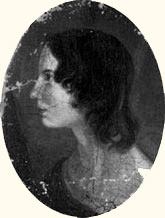Emily Brontë
Critique
 From painting by Branwell Brontë
From painting by Branwell BrontëEmily Brontë
Born
Thornton, Yorkshire, England, 1818
Died
Haworth, Yorkshire, England, 1848
Nationality
English
Publications
Novel, poetry
Genres
Literary, romance
Writing language
English
Literature
• Wuthering Heights (1847)
Novels
• Wuthering Heights (1847)
British Literature
• Wuthering Heights (1847)
From the sisterhood
The story of any of the three literary Brontë sisters—Charlotte, Emily or Anne—is largely the story of them all. Readers who are into the writing of any one of them tend to be into the writing of all three.
Except perhaps for those who consider Emily Brontë's sole novel one of the highest achievements of English literature. For them, Wuthering Heights makes Emily the starring Brontë with the other two play supporting roles.
Which would seem odd to anyone during Emily Brontë's life, as she was completely unknown outside the family circle. Even in the years after her death at an early age, it was older sister Charlotte who was famed as a writer, despite Charlotte's best attempts to promote her middle sister's novel.
Emily spent her entire life in the northern English area of Yorkshire, where she was born the fifth of six children. Two siblings died in childhood, leaving Charlotte, Emily, brother Branwell and Anne. Their father was a church rector and local writer. The isolated parsonage in which they lived bordered on the moors. Their mother died in 1821 when the children were very young.
Alone on the moors
The surviving four would grow up spending long hours together, reading their father's books and creating imaginary worlds about which they would write and share poems and stories. These works have been recreated from surviving scraps and published a century later as Legends of Angria (1933) and Gondal's Queen (1955).
While Charlotte developed friends outside the family and eventually left home to mix with other literary folk, Emily's every venture away from Yorkshire ended with her returning home where she spent much of her time alone on the moors.
In 1845 Charlotte put together a collection of poetry by all three sisters and it was published the next year under the names of Currer, Ellis and Acton Bell—pseudonyms taken by the siblings. Most of Emily's poems seem to have been taken from the Gondal fantasy world of her childhood. The book sold a grand total of two copies.
Meanwhile the sisters each produced a novel under the same names. After her first effort failed to find a publisher, Charlotte's next, Jane Eyre (1847), was accepted and became an immediate popular success. But Emily's Wuthering Heights, published the same year using the Ellis Acton nom de plum, was ignored or mistaken for an inferior earlier work of Charlotte's. Some critics also doubted a woman could have written such a sensual novel at all and attributed it to older brother Branwell.
It was only gradually over the years, long after the Brontës were all deceased, that Emily became known as author of one of the most intense works of passion in the English language and that Wuthering Height's then innovative method of storytelling—with time shifts and multiple narrators whose accuracy cannot entirely be trusted—was recognized for its influence on the development of the English novel.
Branwell had died the year after Wuthering Heights was published, after a long period of decline involving alcohol and opium, and Emily is said to have caught a cold at his funeral, which led to tuberculosis, from which she also died that year. Her younger sister Anne died five months later.
Charlotte's next novel, Shirley (1849), is considered a portrait of Emily.
— Eric
Critique

